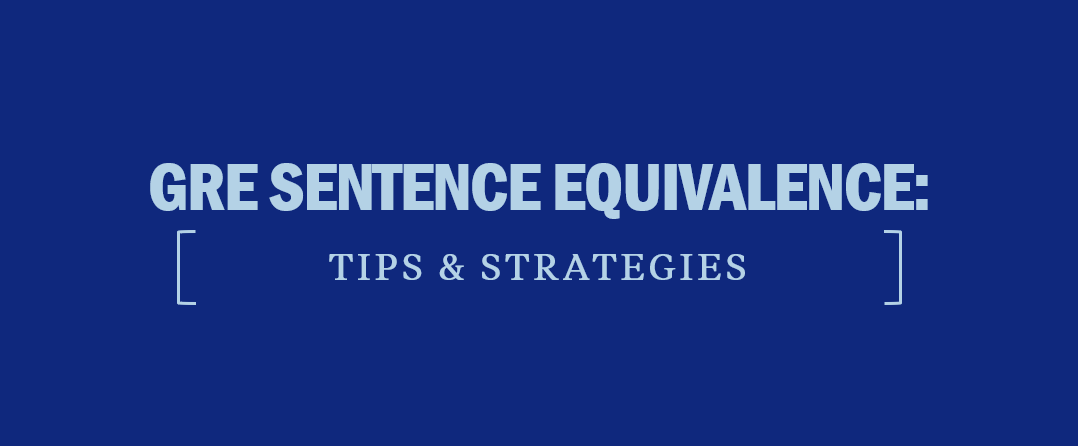GRE Sentence Equivalence: Tips and Strategies
GRE Sentence Equivalence questions consist of a single sentence with a blank space and ask you to select two correct answers from six choices. While these questions may seem straightforward, the answer choices can be tricky, and no credit is given for partially correct answers. Learn how to answer GRE Sentence Equivalence questions with tips and strategies from test prep experts. Review the Kaplan Method for Sentence Equivalence questions, a step-by-step process for answering this GRE question type. Finally, test your readiness with realistic GRE Sentence Equivalence practice questions and get in-depth answer explanations.
[ Read Next: What’s on the GRE Verbal Section ]
About GRE Sentence Equivalence Questions
Each GRE Verbal Reasoning section includes approximately four Sentence Equivalence questions. These sentences will look like the standard “fill in the blank” sentences, but there’s a twist: of the six answer choices provided, you have to choose two. When plugged into the sentence, those choices must create the same meaning; essentially, the words must be synonyms. While the task might feel familiar, this format means there are new obstacles to navigate on your way to the correct answer. You will see approximately eight total Sentence Equivalence questions on the GRE, four on each Verbal section. These questions should take about one minute each.
GRE Sentence Equivalence vs. GRE Text Completion Questions
The Verbal Reasoning measure of the GRE contains two sections with three types of questions: Reading Comprehension, Text Completion, and Sentence Equivalence. GRE Sentence Equivalence Questions and Text Completion questions may seem similar, and both essentially test your vocabulary, but they function differently on the exam. Here is how GRE Sentence Equivalence questions and Text Completion questions differ:
- Sentence Equivalence questions test your ability to determine how a sentence should be completed by using the meaning of the entire sentence. These questions have a sentence with one blank space and ask you to choose two words from the six answer choices that make equivalent and logical sentences.
- Text Completion questions test your ability to read critically – to recognize the meaning of the sentence or paragraph as a whole and to select words that logically fit the blanks. These questions have one to five sentences with one to three blank spaces and ask you to pick words for each blank space separately.
Because of these distinctions, you should approach GRE Text Completion questions and Sentence Equivalence questions differently on exam day. Be sure to review GRE test-taking strategies for each question type.
GRE Sentence Equivalence Question Strategies
Sentence Equivalence Strategy #1: Consider All Answer Choices
Read and check all answer choices in the sentence before making your final choice. An answer may fit well in the sentence and closely match your prediction, but if there is no other answer choice that also completes the sentence with the same meaning, it isn’t correct.
Sentence Equivalence Strategy #2: Paraphrase the Question
If you rephrase a difficult or longer sentence in your own words, it will be easier to make a prediction for the answer. Paraphrasing will also make sure that you understand the meaning of the sentence.
Sentence Equivalence Strategy #3: Look Beyond Synonyms
Simply finding a synonym pair in the answer choices will not always lead you to the correct answer. Answer choices may include a pair of words that are synonyms but do not fit in the context of the sentence. Both of those two choices will be incorrect. The meaning of each sentence must be the same and correct. Try both words in the sentence, checking that each sentence has the same meaning, before making your final choice.
Sentence Equivalence Strategy #4: Use Prefixes, Suffixes, and Roots
Think about the meaning of the prefixes, suffixes, and roots in words that you know if you are struggling to figure out the definition of a word.
The Kaplan Method for GRE Sentence Equivalence Questions
Use Kaplan’s tried-and-true method for tackling GRE Sentence Equivalence questions.
- Read the sentence, looking for clues.
- Predict an answer.
- Select the two choices that most closely match your prediction.
- Confirm your answer by reading your selected choices into the sentence.
Now let’s apply the Kaplan Method to a Sentence Equivalence question.
1. She volunteered to work in a soup kitchen because of her __________________ nature.
- A) selfish
- B) naïve
- C) altruistic
- D) baneful
- E) candid
- F) benevolent
GRE Sentence Equivalence Practice Questions
Try the following Sentence Equivalence practice questions using the Kaplan Method. For each question, select two choices. If you’re up to the challenge, time yourself; on Test Day, you’ll want to spend about one minute on each question.
1. While the abstract impressionist painter Lee Krasner may not be as well-known to the general public as her husband Jackson Pollock, her work is held in esteem by ____________ ; indeed, she is one of the only female artists to have been featured in a retrospective at the Museum of Modern Art.
- A) detractors
- B) neophytes
- C) the cognoscenti
- D) connoisseurs
- E) malcontents
- F) the uninitiated
#1 Answers and Explanation
1. C, D
“While” sets up a contrast; Lee Krasner is not well known to the public, but one group of people, described by the missing word, respected her work. There’s a further clue after the semicolon: her work has been featured in a prominent museum. Thus, you can predict that the blank must mean something like “art experts.” (C) the cognoscenti and (D) connoisseurs both mean “experts,” especially in connection to the arts, so they are the two correct answers. (B) neophytes and (F) the uninitiated are the opposite of what’s needed; both refer to novices or those who are untrained. (A) detractors (“those who disparage or criticize”) and (E) malcontents (“rebels” or “troublemakers”) are both too negative to fit the context of the sentence
2. Although Don Quixote, published in 1605, is a ____________work of Western literature and an early example of the modern novel, it is not, as is sometimes claimed, the first novel; an even earlier contender for that designation is The Tale of Genji, an 11th-century work of Japanese literature.
- A) seminal
- B) derivative
- C) uninspired
- D) canonical
- E) serial
- F) antithetical
#2 Answers and Explanation
2. A, D
The missing word describes Don Quixote’s relation to Western literature. The fact that it is sometimes called the first novel implies that it holds a special place in Western literature, so you can predict that the blank will mean something like “important.” (A) seminal, meaning “influential,” and (D) canonical, meaning “recognized” or “time-honored,” both match this prediction and are correct. (B) derivative would
imply that Don Quixote is based on modern novels; this is the opposite of their actual relationship. (C) uninspired means “dull” or “uninteresting” and is again the opposite
of what you need. (E) serial, or “arranged in a series,” doesn’t fit the context as there is no indication that Don Quixote was published as a series of chapters. Finally, (F) antithetical means “opposite.” Since the sentence indicates that Don Quixote is an early modern novel, this choice can be eliminated.
3. Although the lab assistant openly apologized for allowing the samples to spoil, her ______________ did not appease the research head, and she was let go.
- A) insincerity
- B) frankness
- C) falsehoods
- D) candor
- E) inexperience
- F) hesitation
#3 Answers and Explanation
3. B, D
The clue in this sentence is the detour road sign “although,” which indicates contrast. Her “open” apology would be expected to “appease” her boss, but she was fired anyway; paraphrasing further, she did something good but suffered bad consequences. The word in the blank will express the good thing she did, so you can predict that the correct answers will be similar to “honesty.” Choices (A), (C), (E), and (F) are not synonyms for “honesty,” leaving choices (B) and (D). (B) frankness and (D) candor both carry the meaning of “forthright.” They’re your answers.


